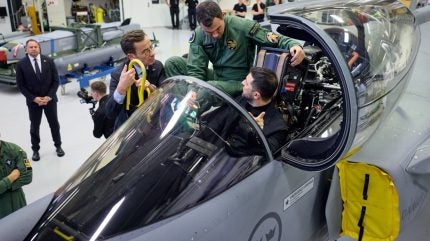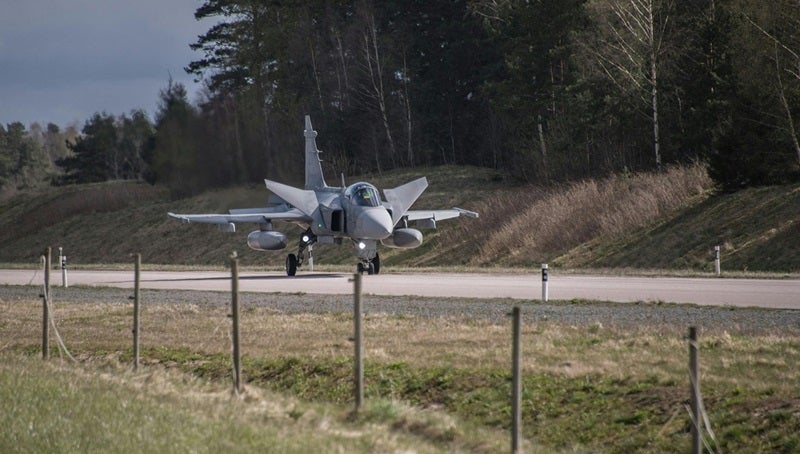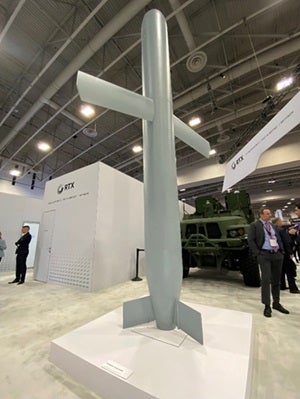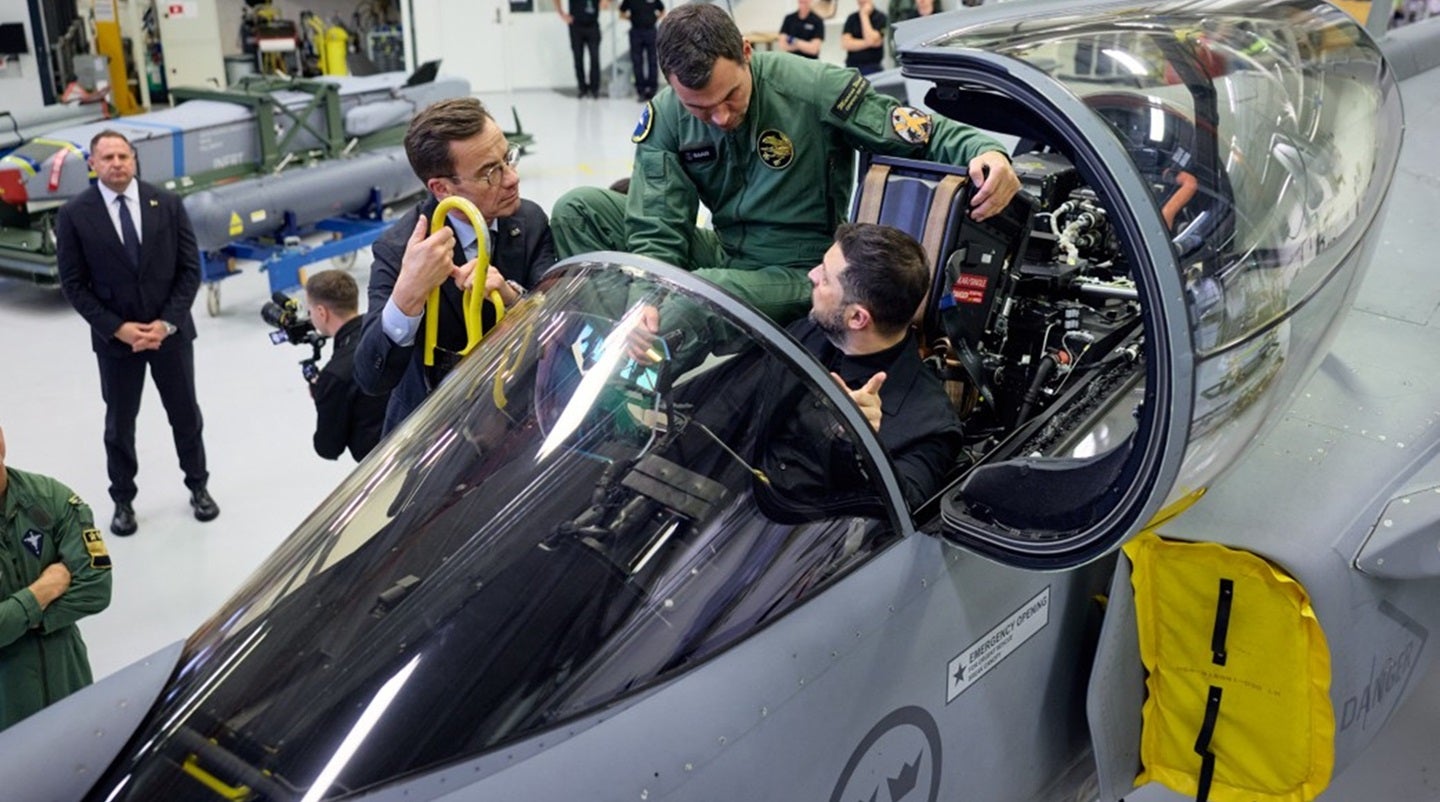
Volodymyr Zelenskyy (seated) and Ulf Kristersson (left) were briefed on the Gripen aircraft, the Swedish weapon systems, and simulators at Saab’s facility at Linköping airport. Credit: Office of the President of Ukraine.
Ukraine will receive its first JAS 39 Gripen fighter aircraft sometime in 2026, as Sweden sets a path to send between 100-150 jets to the country over the next ten to 15 years.
A letter of intent to this effect was signed between Swedish prime minister Ulf Kristersson and Ukrainian president Volodymyr Zelenskyy in the Swedish city of Linköping on 22 October 2025.
 Discover B2B Marketing That Performs
Discover B2B Marketing That Performs
Combine business intelligence and editorial excellence to reach engaged professionals across 36 leading media platforms.
Saab briefed both leaders on the aircraft in service with the Swedish Air Force, the weapon systems used on the platform, and the simulators and training capabilities associated with the fighter jet. According to GlobalData intelligence, the Nordic nation flies 95 of the earlier Gripen C/D jets and has just two of the latest single-seated E units in service.
An advancement on the previous version, the E version includes an active electronically scanned array radar system, around 30% more fuel capacity, and integrated artificial intelligence capabilities that can perform complex manoeuvres, according to Saab.
Neither government confirmed what type of Gripen will be sent to Ukraine, but considering the lengthy delivery period it will likely be the latest Gripen E variant as this will take time to produce.
Still, Kristersson noted, “this will help build a very strong Air Force in Ukraine, which will become part of the large family of fighter jets.” Currently, Ukraine operate a mixed variety of combat aircraft, including the American F-16 Fighting Falcon and French Mirage 2000, but it also flies a number of legacy fighters from the Soviet period such as the MiG-29 and Su-27.
Why Gripen, then?
“These are great aircraft, strong aviation platforms capable of performing a wide range of missions. Everyone can see what threats they help counter,” said Zelenskyy, somewhat cryptically.
In terms of the suitability of the Gripen, it has relatively low operating costs and is easy to maintain. The Swedes are also trained to operate it using roads and highways so its able to operate well in the austere conditions faced in the war-torn nation.
 A Swedish Gripen fighter lands on a highway. Credit: Nato.
A Swedish Gripen fighter lands on a highway. Credit: Nato.
In late May, the Swedish Air Force pilots were learning to take off and land on civilian roads near Gothenberg. It should be noted that a Nato press release at the time explained that these roads have been deliberately engineered to accommodate landings by fighter jets
Once on the ground, the Gripens made use of a mobile forward arming and refuelling point, replenishing in a matter of minutes before taking off again.
This flexibility is a critical part of Sweden’s recent commitment to the Agile Combat Employment concept where combat air units are scattered across home bases and geographically dispersed locations.
“It’s especially useful when a country anticipates a crippling first strike on its key air bases by a stronger adversary and expects them to be taken out rather quickly,” observed GlobalData defence analyst, Abhijit Apsingika. “In such a scenario Gripen’s short take off and landing capability would be indespensible to retain combat potential. As such it is near perfect for Ukraine.”
This notion is pertinent when it comes to protecting Ukraine’s critical infrastructure, particularly energy plants, “which continue to suffer from Russia’s constant attacks” Zelenskyy said in his discussion with Kristersson.
Ukraine continue to seek American weapons
Ukraine’s head of state also touched on the need to pressure Russia into a peace agreement.
To this end, in the immediate term, Zelenskyy emphasised a requirement for long range weapons to strike deep inside Russia, namely Tomahawk land attack cruise missiles (TLAMs), which are an all-weather, long-range, subsonic cruise missile used for deep land attack warfare.
 Model of a Tomahawk cruise missile, AUSA 2025, Washington DC. Credit: John Hill/Airforce Technology.
Model of a Tomahawk cruise missile, AUSA 2025, Washington DC. Credit: John Hill/Airforce Technology.He maintained that TLAMs will be bought with European financing through the Prioritised Ukraine Requirements List (PURL) initiative, which as of the end of September, totalled more than $2bn. This list also includes missiles for Patriot and HIMARS air defence systems.
TLAMs are said to costs around $2.2m and a launcher about $6.2m. About a thousand Tomahawk missiles are available for transfer to Ukraine in the US stockpile today.
According to the Center for Strategic and International Studies in Washington, TLAM deployment could have a major impact on the Russia-Ukraine war, “but they would need to arrive in Ukraine quickly if they are to give President Trump the leverage he needs to get Russia back to the negotiating table,” it was suggested in the latest report.

